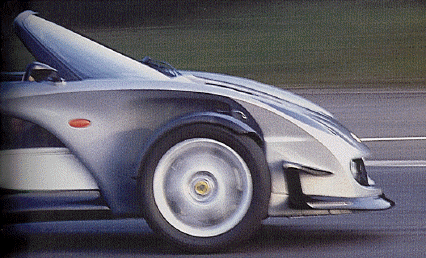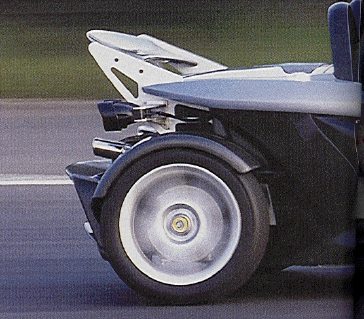The Day Of The Power Test
by Donald from Switzerland (copyright 2001)
It’s 8:00 AM on a Tuesday morning in January. It’s freezing cold (around 5 degrees Celsius). I’m waiting in front of the technical testing hangar of the Swiss Touring Club in Füllinsdorf in the Basle district.
At last the door is opened by the technical expert and I drive in, straight on to the rollers.
The rollers beneath the front and rear axles are a pair of 2 metre wide metal rollers which have a diameter of about 50 centimetres and which protrude above ground level by about 5 centimetres.
Between the rollers (where car no 333 is now standing) there is a ‘support bridge’ which can be lowered so that the tyres are just in contact with the rollers
Slowly the expert lowers both the ‘support bridges’ and in this way the car sinks downwards.
I kneel, and then lie down on the floor, in order to check how much clearance there is under the front spoiler and also to see if the car has contact with the rollers. With 1.5 Centimetres clearance between car and ground there is finally contact between wheels and rollers – pretty tight!
The expert thought that this was barely enough clearance.
After removal of the nine screws which secure the engine compartment lid, a thermostat is inserted to replace the oil level dipstick and an induction sensor is clipped onto the high tension leads to measure RPM.

The expert gives me a pair of ear defenders and both in front of and behind the car some knee high ducts pop up in order to remove exhaust gasses with a stream of air.
The measuring computer is programmed and the expert climbs gently over the side and devoutly takes his place in the drivers seat.
Luckily, apart from the starter button, everything else works like a ‘normal’ car! He tries all the gears and then finally he starts the test.
By using a remote control he is able to operate the test equipment from the drivers seat. He accelerates with full throttle up to the rev limiter. This takes quite a while and the noise becomes ever more deafening with eventually the humming of the rollers almost drowning out the noise of the engine!
As soon as the rev limit is reached, the expert releases the accelerator and lets the car “coast” i.e. leaves it in gear, and the engine is slowed from its maximum rpm to about 2000 rpm by solely by the resistance of the rollers. Because the drag which would normally occur on the road at about 160 km/h is missing, this process takes quite a long time.
And now : Turn off the engine, climb out of the car, examine the computer printout, particularly the transmission loss curve which appears to have an irregularity probably caused by the operation of the rev limiter- so repeat the testing process once more.
After the second test – I am already half deaf and I am reminded of Richard Morris’s joke about starting Concorde- it becomes apparent that the test is OK.

I eagerly study the computer printout. Relatively similar curves for power and torque, although because the curve is calibrated in kW, at first I do not understand what it means. 148kW?
The expert taps into his pocket calculator : 148 x 1.36 = 201
201 PS (editors note : 201 PS = 197.8 BHP)
That’s over 20 PS more than the car could/should have!!
I carried out the power test to check if the car would reach its specified 180 PS so OK 201 PS will do very nicely.
Back at home checking the torque curves for car No 333 against the standard figures I notice that these are as per specifications but even so 201PS is a nice figure (even though I would prefer a higher torque figure which might be more useful from a practical point of view).
On these figures No 333 has 304 PS/Tonne (maybe a nought got displaced…. ;-)
The next power test will be carried out after the installation of a Cat Replacement Pipe, then we’ll see……….
Editor's note : Donald's car is standard factory specification.
To see Donald's power test results click here